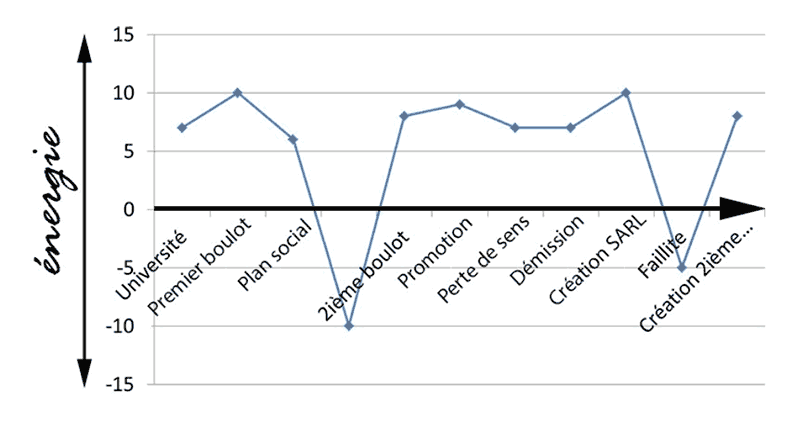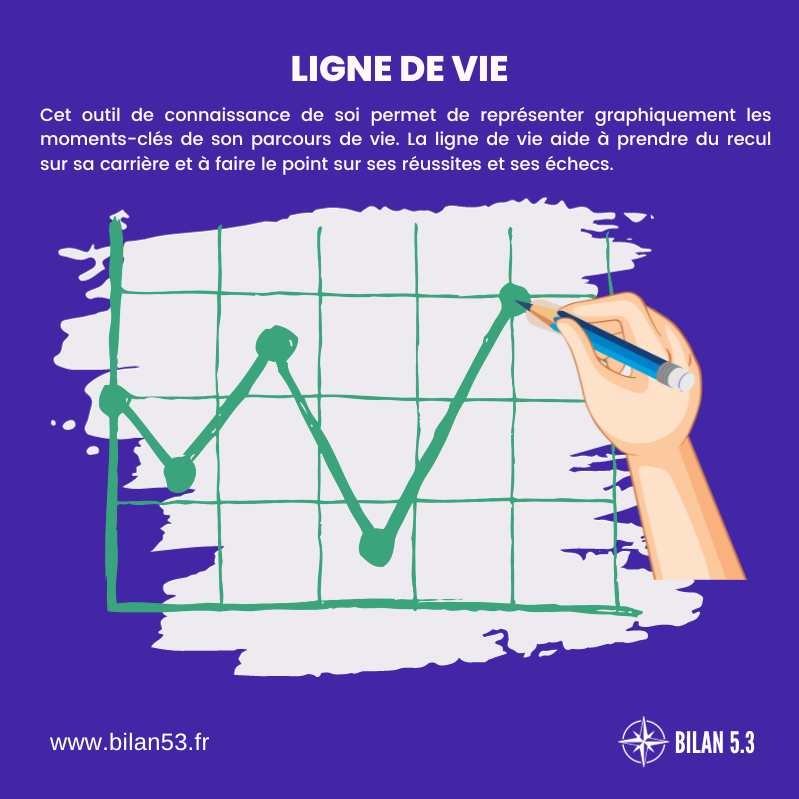The life line, sometimes called the “life curve” or “time line”, is a tool for self-knowledge which allows us to graphically represent the significant events in his life. It allows you to take a step back from your career, take stock of your successes and failures and identify the key moments of your journey.
By representing events in terms of energy, the life line makes it possible to highlight promising, favorable and mobilizing situations, and those which, on the contrary, led to “demobilization”. This analysis can be used to identify effective strategies for remobilization and achieving its objectives.

Observing the graph is enlightening for identifying the recurring cycles and the circumstances that lead to “demobilization.” We can also deduce the profitable strategies in terms of remobilization…
In the background appear your mobilizing beliefs or your limiting beliefswhich can explain the variations of the curve. By identifying them, you have the opportunity to think about how to give up those that prove unfavorable, to keep only those that contribute to strengthen your motivation.
What is your lifeline for?
The objective of the Lifeline is to obtain a finer idea of the dynamic in which you find yourselfare today, in your life journey. You will clarify the mechanisms that may have guided your life (important stages of your life and career, recurrence of characteristic cycles (beneficial or not) and the strategies that you implemented to react.

Your Lifeline will help you develop a positive vision of your journey and your resources. It allows you to revisit your successes but also your failures. You will become aware of your capacity for resilience in the delicate turns that you had to negotiate.
This tool is especially useful during periods of life transition Or career reorientationwhen it comes to clarifying the sources of motivation over a long period of time. It will prove relevant to enable you to make the right choices for the rest of your journey.
How to create your Lifeline?
First, download our free Lifeline template to print.
- Remember the key events in your professional life, from your first job (after school) to today. No need to list them in detail, trust your intuition to list them spontaneously.
- You will name each event and position it on the diagram in the form of a point (one-off event) or a level (more lasting stage).
- Next, you will connect the points to draw a curve.
- You will then step back and look at the curve to spot what will jump out at you.
- You may be able to continue your analysis in the company of the person of your choice, a coach or an advisor.
The vertical axis of the Life Line corresponds to the energy level felt during each event: summits correspond to periods of high energy (success, promotion, satisfaction, etc.), and the valleys during calmer periods (reflection, introspection, search for “better”), sometimes positive for some.
Alongside professional events, it may be useful to also mention personal events significant (baby, death of a loved one, etc.) and even training when these represent the start of a notable change.
We can also choose to plot two curves of different colorsone for professional life, the other for personal life. The analysis of the interactions between the two curves can then prove enlightening: it is not uncommon for extra-professional events to be the driving force behind successful professional changes.
Drawing your Lifeline requires a significant mental availability and great kindness towards oneself. It is in fact the absence of judgment that allows you to be most honest with yourself, otherwise the graph cannot be perfectly authentic.
How to interpret your Life Line
You will observe your life journey by taking a step back. This will allow you to put events in their rightful place, and to take a new look at yourself, resolutely benevolent and open to the future.
When you decipher your Lifeline: consider it in its entirety (ascent, fall, recurring cycles, etc.), then try to interpret the mechanisms that characterize it. These are the factors or events at the origin of the valleys and those which, conversely, stimulate your energy and make it rise.
Try to identify the recurring phenomena to be able to anticipate their consequences in the future and, if necessary, give you the means to limit (or avoid) them.
You can also ask yourself questions to take the decryption further:
- Overall, who decides the change (rather me or an external element that imposes itself on me)?
- What is my motivation for change (encounters, boredom, disappointment, anger, etc.)?
- Where do I get my motivation to stay in a job? How are my energy reserves renewed? What strategy to go back up?
- What beliefs guide my choices? Am I satisfied with these mechanisms, or what do I want to change in the future?
- How would I like my Lifeline to evolve in the next five years? What would allow me to flourish more?















